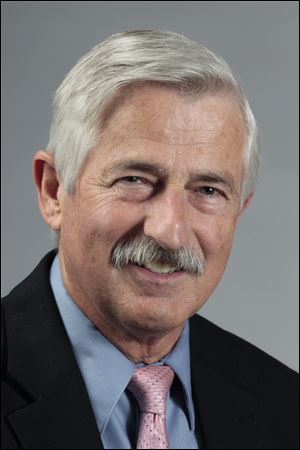
COMMENTARY
This water expert was no Chicken Little
8/11/2014
Walton
If anybody has a right to say “I told you so,” it’s Tom Kovacik. When he and I sat down in January to talk about western Lake Erie's deteriorating health, he predicted with certainty that our end of the lake would experience an environmental disaster within two years.
Just seven months later, the train wreck that is the Algae Express has arrived. Half a million people were suddenly told not to drink the water from their taps, because the algae blooms surrounding the City of Toledo’s water intake had contaminated it.
Pea soup. Green paint. Call it what you want. It’s a hot mess, and it made Toledo a national story.
Mr. Kovacik has been warning us all of an ecological catastrophe for the past few years — usually to the sound of one hand clapping. He’d have taken a bullhorn to the top of Perry’s monument at Put-in-Bay if he thought it would do any good.
“This is exactly what I would have predicted,” he says. “The toxic algae is being fed by nutrients and phosphorus, but pathogens are dangerously contributing to the toxicity.” The pathogens, he is convinced, are coming from Facility 3, the man-made landfill that juts into Maumee Bay.
Agricultural runoff into the Maumee River is a major source of the phosphorus. But the City of Bowling Green draws its water from the river and was not affected by the crisis in Toledo and its suburbs. So the bad stuff in the lake is fed by an additional source, Mr. Kovacik insists.
He brings credibility to his crusade. He once was the City of Toledo’s chief chemist, and later served as utilities director and chief operating officer under former mayor Carty Finkbeiner. He is hardly Chicken Little in a lab coat.
“Only a fool can ignore the 800-pound gorilla now,” he says. He is 100 percent convinced, he adds, that Facility 3 was and remains a significant contributor to the problem.
Despite a relatively dry spell recently, 2014 has been a wet year that has produced billions of gallons of water that ran off, under, and through Facility 3, he argues, and led to leaching from the bottom of the facility, something he’s convinced will be proven eventually.
In the meantime, Toledoans, forced to queue up with their jugs and other containers at water distribution centers, could be excused for feeling as if they suddenly lived in some Third World nation. Toledo became a major and embarrassing story on national television newscasts.
Restaurants closed and lost significant business, while those that were unaffected saw opportunity. An electronic sign at one fast-food restaurant in Bowling Green offered “free water in your jug with purchase of a combo.”
Public service or profiteering? There was some of the latter. But it is human nature to band together in times of crisis. The stories of neighbor helping neighbor, stranger helping stranger, far outnumbered incidents of greed overtaking the spirit of brotherhood.
Government, on the other hand, has failed us. The City of Toledo, the State of Ohio, and the feds should have been on top of this disaster long before the summer of 2014. Fixing what’s broken — and regaining public confidence — is going to be a long slog.
“We have not been good stewards of that natural resource,” Toledo Mayor D. Michael Collins said of Lake Erie when the ban on drinking the water was lifted. Gee, do you think?
We can also imagine the jokes that are making the rounds elsewhere in the nation, where ridiculing the Rust Belt and cities such as Toledo is considered great sport. Yet how many times have we watched and read news accounts of forest fires or droughts in California and thought to ourselves: “Wow, we’re lucky to live in a place where we have all the water we need.”
Well, yes, but ...
Toledo’s crisis should put cities all around the Lake Erie shoreline — in the United States and Canada — on full alert. There is no room for smugness just because Lucas County got the worst of it. This is an ongoing calamity. The satellite images reveal just how extensive these algae blooms are, and they are scary.
When I wrote last winter of Mr. Kovacik’s efforts to warn the public about the deterioration of the western Lake Erie basin, I took note of his critics and concluded with this thought: “So who’s right? If it’s Tom Kovacik, be afraid. Be very afraid.”
Maybe, at last, the 500,000 or so people who get their drinking water from the City of Toledo are afraid. Let’s hope schoolchildren are not one day taught about the “four” Great Lakes and one really big emerald-colored encrusted pond.
Thomas Walton is the retired editor and vice president of The Blade. His column appears every other Monday. His commentary, “Life As We Know It,” can be heard each Monday at 5:44 p.m. on WGTE-FM 91.
Contact him at: twalton@theblade.com